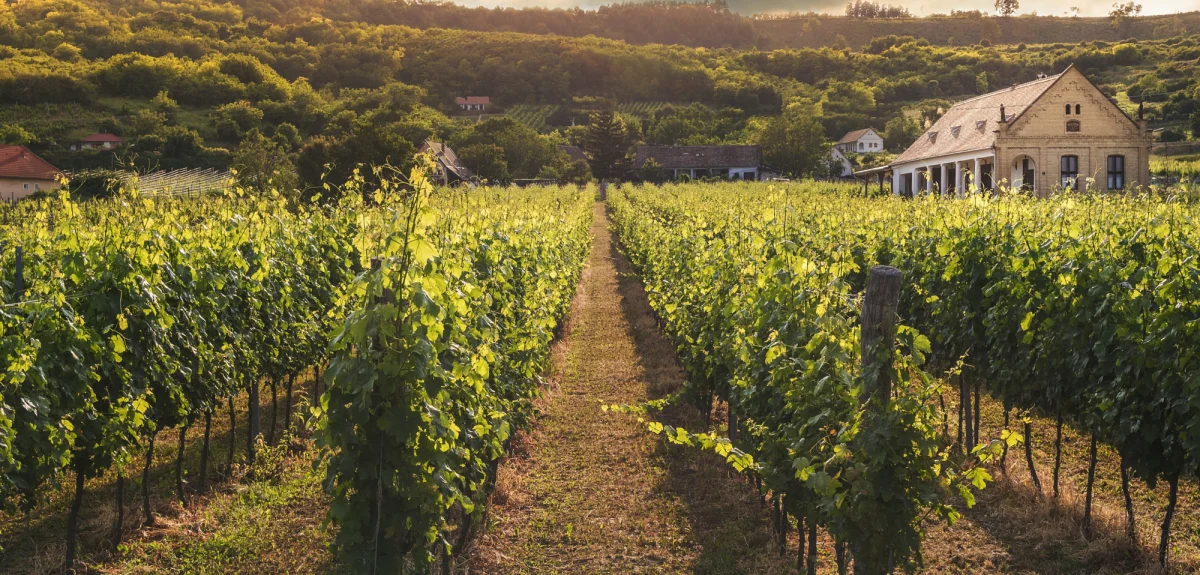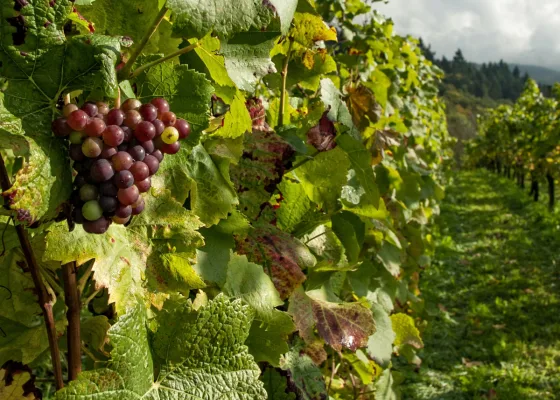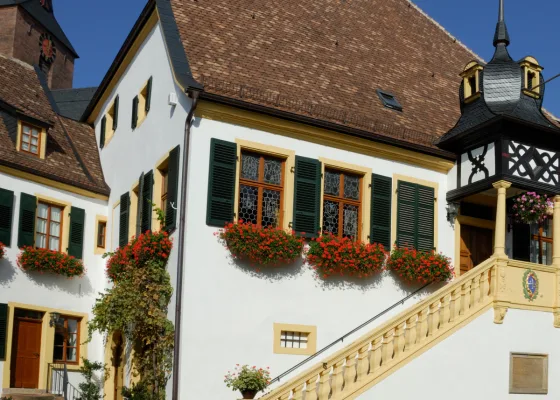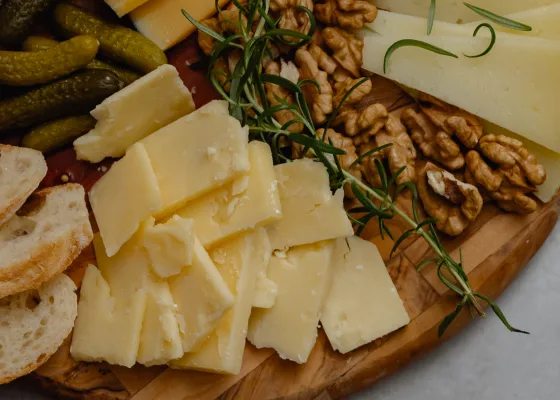
The German wine route
An ultimate road trip from Frankfurt to Stuttgart.
In densely populated Germany, you’re never far from something new. Around an hour south of the skyscrapers in Frankfurt’s financial district lies the Pfalz region. Knitting together charming villages and soft rolling hills is the 85km German Wine Route, and driving there in the autumn means traveling through a colorful patchwork of yellow, red and green from endless lines of vineyards.
The Romans realized early on that this was a special place. On their arrival in the 1st century, they were welcomed by a warm, almost Mediterranean climate. Besides viniculture, the Romans also brought almonds, figs and lemon trees to the region, while today you can even see saffron, kaki and kiwis grown here.
First stop: A family-run vineyard
Despite, or perhaps because of, the long traditions in the area, a new kind of wine culture is emerging in Pfalz. Coming from the north, you can get a taste of it at the first stop, the Gaul winery.
“My family has been making wine for five generations and now my sister Karoline and I run the business,” Dorothee Gaul says.
Between the vines stands a three-story high cube with a façade of rusty steel and a tasting room where guests can try the wine and, if they’re lucky, some of Dorothee and Karoline’s mother’s cake. Together with other young wine growers, the Gaul-sisters are part of a new generation in Pfalz.
“We are all friends who meet to try each other’s wine and we all profit by working together,” she says.

Family traditions in Pfalz
Weingut Gaul

Sisters Dorothee and Karoline Gaul are practitioners of the new wine culture in Pfalz while at the same time maintaining long-held family traditions. Two holiday apartments available.
Head towards premium sausage and sauerkraut in Bad Dürkheim
With two holiday apartments it’s tempting to stay, but there’s much more to discover, and the trip continues south to Bad Dürkheim. The spa-town has beautiful public gardens and a 330m-long graduation tower, formerly used to produce salt. Today, you can cross it, inhaling saline air as fresh as a sea breeze as you go.
Bad Dürkheim is also home to the biggest wine festival in the world, attracting 600,000 visitors in September each year. Known as the Wurstmarkt (the sausage market) you will certainly find the region’s most famous dish, Saumagen. The name translates as “pig stomach” and that, filled with pork, potatoes and spices, is exactly what it is.
“It is, in fact, a sausage and a premium one, made with the best meat containing only 5% fat. Cut in slices you fry it and serve it with sauerkraut and a glass of Riesling,” says Klaus Hambel from Metzgerei Hambel in Wachenheim.
Hambel’s butcher’s shop is considered to make the best Saumagen in the region, which, by extension, means the best in the world. Three shop assistants sell a wide variety of sausages as they greet most customers by name. Hambel’s most famous customer however, was former German chancellor Helmut Kohl. Using Saumagen-diplomacy, world-leaders including Thatcher, Gorbachev and Reagan were invited to nearby Deidesheim to eat specialties from Kohl’s beloved home-region.

A world-famous charcuterie
Metzgerei Hambel

Butcher Klaus Hambel has been making his world famous sausages and “Saumagen” since 1985. Across the street is his restaurant “Klaus Hambel”.
Continue towards Deidesheim and award-winning Riesling
A stop at Deidesheim is a must-do. It’s a picturesque gem with half-timbered houses, while its combined town hall and wine museum wouldn’t look out of place in a fairy tale. Young and old meet in the cozy Weinstube Kirchenstübl and the town is regarded as the cradle of German quality wines.
“There are 7km of cellars below this town with hundreds of thousands of bottles,” says Klaus Küster from the Reichsrat von Buhl winery.
Together with Basserman-Jordan and Dr Deinhard, they form the region’s most important wine estates with some of the world’s best vineyards for Riesling.
With two Michelin-star restaurants, Deidesheim is a culinary stronghold. But even the smallest villages along the Wine Route have at least one restaurant serving excellent traditional food. And just like with the wine, a new generation is reshaping culinary traditions.
Among narrow alleys on the outskirts of Neustadt lies the restaurant Quetschekuche Stubb with tables outside in a courtyard next to fig trees. The menu is a modern take on the local specialties Maultaschen (ravioli), Leberknödel (liver dumplings) and, of course, Saumagen.
“There has to be Saumagen! But we also want to offer something new and along with vegetarian alternatives,” says owner Meinolf Sachse who serves every dish with large portions of fresh salad and wine from the surrounding hills.

Modern cuisine
Quetschekuche Stubb

Restaurant in a historical building serving modern versions of local cuisine and excellent wine.
Hambacher Schloss – the birth of democracy in Germany
Before continuing south, Sachse jokes that they’re “practically swimming in wine here.” And it’s clear what he means. The landscape is covered with grape vines. They even grow in the villages, on walls and climbing between houses. Beyond lie wooded hills where you’ll come across several romantic castles, the most famous of which, Hambacher Schloss, is reached via a small road through a beech forest.
In 1832, liberal intellectuals held a political meeting with demands for freedom of press and democracy under the guise of a huge party Tens of thousands turned up and the event is seen as the birth of democracy in Germany. An interactive exhibition explains the importance of the event, while the restaurant 1832 offers ambitious, good value food in a modern and award winning side-building.

A castle of importance
Hambacher Schloss

The most famous castle along the Wine Route. In 1832 a big party was held here which is seen as the beginning of the democratic movement in Germany.
Take a detour to Doktorenhof
For an interesting and somewhat bizarre experience it’s worth making a small detour to Doktorenhof in Venningen.
“Please put this on,” Georg Heinrich Wiedemann says, handing over a monk’s robe and showing the way to the cellar. Gregorian choirs sing from hidden speakers and in the air there’s an unmistakable aroma of vinegar aging in barrels.
“We’re now in the most holy room where 150-year-old bacteria turns the wine into vinegar,” he says.
Afterwards, fruits and spices from his garden are added according to secret recipes. “For me, vinegar is culture. It’s good to drink as an alcohol-free aperitif or digestif,” Wiedemann says.
Next stop, Landau.

The vinegar manufactory in Venningen
Weinessiggut Doktorenhof

Vinegar producer Georg Heinrich Wiedemann offers an unusual experience in a beautiful building with dozens of different vinegars with spices and fruits to choose from.
The last stops before Stuttgart: Landau & Kleine Kalmit
Vendors sell local fruit in the town square while those finished buying groceries enjoy the autumn sun outside the many cafés.
“For all of us in wine-growing regions, food plays an important role in daily life here” says Uta Holz during lunch at Südpfälzer Genusszentrale of wild boar salami, hard cheese and German liver sausage, Leberwurst.
Uta Holz works for the German Wine Route and explains that Pfalz is proud of its hearty image, both in terms of its food and its people.
“When you enter a Weinstube you always share a table with others,” she says. Minutes later the we find ourselves talking and sharing bread with the others at the table.

Local specialties
Südpfälzer Genusszentrale

Modern wine bar, restaurant and food shop with local specialties from Pfalz in the center of Landau.
The lunch could easily be extended to a dinner, but before heading to Stuttgart it’s time for one last stop at the Kleine Kalmit nature reserve. A path between grapevines ends at a small chapel at the summit of the 270m-high hill which offers panoramic views over the splendid landscape, and as the sun sets behind the rolling hills it’s hard to imagine a better way to end a trip on the German Wine Route.
Driving in Germany
The Wine Route as well as other roads in the region are all in excellent condition. Generally, no international driving license is required. Driver licenses from the EU/EEA are valid, while for other countries, different rules may apply.
Germany is famous for its Autobahn motorways with no speed limit, indicated by a white sign with five black stripes. Around urban areas however, the speed limit is 130 km/h. Within built-up areas you’re allowed to drive 50 km/h, and 80-100 km/h outside. On the Autobahn, if the car in front of you starts blinking its hazard lights, slow down and expect to find yourself in a traffic jam (Stau) before long.
If you are in a traffic jam on the Autobahn, remember to move to the side of the road to leave space between the lanes for an ambulance or police car to get through. And remember, on the Wine Route the maximum level of alcohol in the blood is the same as everywhere else in Germany – 0,05%. Don’t drink and drive!
About Germany and its wine
Germany is the world’s eighth largest wine producer and has 13 official wine growing regions. Pfalz is the second biggest – after Rhein-Hessen – and the world’s biggest region for Riesling. White wines account for two thirds of production, but the demand for red wines is steadily growing, with Pinot Noir/Spätburgunder being the most common grape.
With an average German wine consumption of 20,9 liters per person, the country is behind the major producers, such as France (50,7 liters) and Italy (44 liters). However, consumption in Germany varies from region to region and it’s hardly a surprise that the people in Pfalz are the most heavy consumers per head.
Text by Carl Undéhn